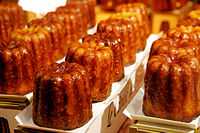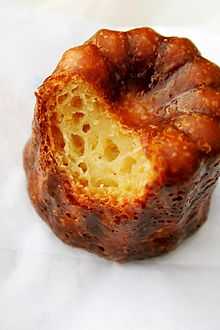Canelé
| Canelé | |
|---|---|
| breakfast, tea, dessert | |
 | |
| Alternative name(s): | |
| Cannelle | |
| Place of origin: | |
| France | |
| Region or state: | |
| Bordeaux | |
| Creator(s): | |
| Couvent des Annonciades (18th century) | |
| Serving temperature: | |
| Room temperature | |
| Main ingredient(s): | |
| flour, milk, egg yolk, butter, vanilla, rum, cane sugar | |
| Recipes at Wikibooks: | |
|
| |
| Media at Wikimedia Commons: | |
|
|

A canelé is a small French pastry with a soft and tender custard center and a dark, thick caramelized crust. The dessert, which is in the shape of small, striated cylinder approximately two inches in height, is a specialty of the Bordeaux region of France but can often be found in Parisian pâtisseries as well. Made from egg, sugar, milk and flour flavored with rum and vanilla, the custard batter is baked in a mold, giving the canelé a caramelized crust and custard-like inside.
Ladies of the Annonciade
Legend has it that that canelés were started during the landing of the boats of flour on the quays of Bordeaux. But more realistically, they would have been created and invented in the 18th century by the nuns of the convent of Annonciades, in Bordeaux, today convent of the Mercy, under the name of canelas or camelions. Those first canelas did not yet look like canelés: they were small cakes of very thin dough rolled around a stick and fried.
During the recent remodeling of this convent, archaeological searches took place. Among the numerous objects found from the appropriate time period, nothing looked like a Canelé mold. Also, there is no record of any repairs to a Canelé mold being found. So it is unlikely the convent is the origin of the Canelé.
The "Canauliers" from Bordeaux
In Limoges there was a food called “canole”, a specialty consisting of bread made with flour and egg yolks. It is possible that this is the same product as the one sold in Bordeaux since the 18th century under the name of “Canaule”, also written “Canaulé” or “Canaulet”. They were so popular that artisans specialized in baking them. These special bakers were given the name “Canauliers”. These artisans registered a Corporation (or guild) with the Parliament of Bordeaux in 1663. This incorporation only allowed them to make a few very specific foods — “Blessed bread”, “Canaules”, and “Retortillons.” But, since they were not a part of the Pastry Corporation (Guild), they were prohibited from using milk and sugar. Doughs containing milk and sugar — known as “mixtionnée” — were reserved to the Pastry Corporation (Guild). Some claim they were scared of the competition from the “Canauliers”.
A war between the “Canauliers” and the Pastry Chefs on the use of the “mixtionnée” dough followed. A March 3, 1755 ruling of the council of State in Versailles gave the “Canauliers” victory over the Pastry Chefs.
The “Canauliers’” Corporation grew to the point that an edict of 1767 limited the number of authorized shops in a city to eight. It created very strict requirements for joining the profession.
But this limit on “Canauliers” shops was never respected. And in 1785 there were no fewer than thirty-nine Canauliers in Bordeaux, among which at least ten were in the district of Saint-Seurin. The French Revolution abolished all the Corporations but not the profession of Canaulier, however census rolls continue to show shops of Canauliers and bakers of “Blessed bread.”
Are Canaules or Canoles the ancestors of our modern Canelé? It seems likely from the word’s etymology. On the other hand no text, shop inventory, nor archives of the Corporation hint at molds. And even less at the shape of the molds used for cooking those “Canaules”.
The Bordeaux wine industry also may be a reason that Canelés are concentrated in that part of France. Traditionally Bordeaux wines are clarified with egg white, leaving the yolk behind to use for cooking.
The Eclipse of the 19th Century and the Explosion of the 20th Century
During the 19th century, Canauliers disappeared from the artisans list of Bordeaux.
In the first quarter of the 20th century the Canelé reappeared, even if it is difficult to date exactly when. An unknown pastry chef repopularised the antique recipe of Canauliers. He improved it by adding rum and vanilla to his dough. It is likely that its current shape comes from the similarity (in French) of the word wave with the word “cannelure” (fluting, corrugation, striations).
The modern name Canelé is recent and mysterious. The “Guide Gourmand de la France” (Publisher: Gault and Millau, 1970) does not mention it. It was only in 1985 when the Brotherhood of the Canelé of Bordeaux was created that the second "n" of its name was abolished to better affirm its identity. The name Canelé became a collective brand, deposited to the National Institute of Industrial Property of France by the Brotherhood. The Canelé met success and, ten years after the deposit of the brand, there were at least 800 manufacturers in Aquitaine and 600 in the Gironde. In 1992, Gironde alone consumed an estimated 4.5 million Canelé. Today, Canelés are so famous that they can be even bought at Bordeaux's McDonald's.
The correct use of canelé
The Canelé is consumed for breakfast, for snacks, and as dessert. Produced in numerous forms and sizes depending on mould size, its consumption varies. It is notably appreciated during tastings of syrupy wines.
Traditionally Canelés or Cannelés of Bordeaux are generally sold in bunches of 8 or 16. In Paris at least, most of the famous shops such as Laduree and Pierre Herme still spell it as Cannelé of Bordeaux with double 'n'. Amongst French pastry shops, the spelling Cannelé is prevalent still to this day.
It is better to serve the small Canelé or Cannelé with cocktails, and the big version for dessert at the end of a meal. The drink matters little, as the Canelé accommodates itself equally well with champagne as with tea, and goes with all of types of wine.
The Canelé is light and easy to carry or ship, thanks to its solidity. If it collapses during transportation, it deforms little and a light reshaping makes it revert to its initial shape.
Ingredients
- whole milk
- unsalted butter
- cake flour
- salt
- baker's sugar
- egg yolks
- dark rum
- vanilla extract
External links
| Wikimedia Commons has media related to Canelés bordelais. |
- cooking show from Brigitte's Rendezvous Salt Spring Island BC (Canada)
- Canelés: The New Madeleine?
- Chow: The Perfect Canelé